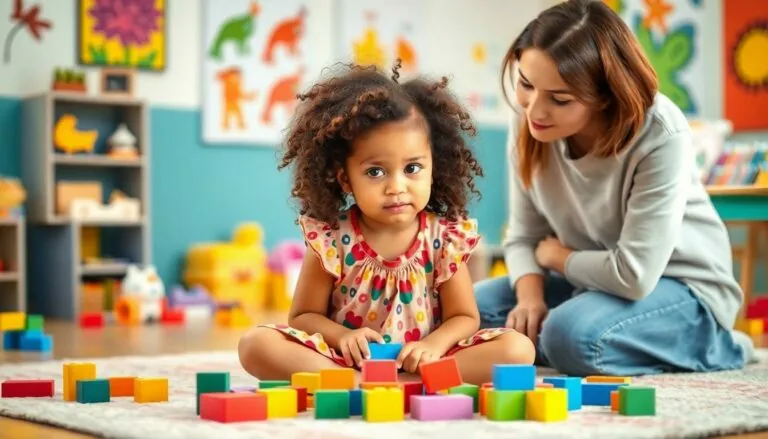Raising kids can feel like juggling chainsaws while riding a unicycle – one wrong move and chaos ensues. For many parents the daily struggle to maintain composure often ends in raised voices and feelings of guilt. It’s a familiar scene: toys scattered everywhere sock pairs missing and siblings fighting over the last cookie. Before they know it parents find themselves yelling again despite promising they wouldn’t.
Breaking the yelling cycle isn’t just about volume control – it’s about transforming the entire parent-child dynamic. The good news? There are proven strategies that can help parents communicate more effectively without raising their voice. By understanding the triggers that lead to yelling and implementing positive discipline techniques families can create a calmer more nurturing environment where both parents and children thrive.
Table of Contents
ToggleUnderstanding Why Parents Yell at Their Children
Parents yell at their children when emotions override rational responses to challenging situations. Understanding these triggers creates opportunities for positive behavioral changes in both parents and children.
Common Triggers for Parental Yelling
Parents often raise their voices in response to specific behavioral patterns. These triggers include:
- Repeated requests for basic tasks like cleaning rooms putting away toys
- Direct defiance such as ignoring instructions running away refusing tasks
- Morning routine delays causing tardiness for school work
- Aggressive behaviors between siblings hitting pushing taking toys
- Safety concerns like running into streets climbing dangerous objects
- Technology overuse beyond agreed screen time limits
- Homework resistance procrastination incomplete assignments
- Mealtime battles refusing food making messes leaving the table
The Impact of Stress and Overwhelm
External stressors significantly influence parental reactions to children’s behavior. Work pressures financial concerns time constraints create a heightened state of tension making parents more reactive. Parents experiencing chronic stress exhibit:
- Decreased patience for normal child behaviors
- Physical symptoms including headaches muscle tension fatigue
- Emotional responses such as irritability anxiety frustration
- Reduced capacity to process multiple demands
- Impaired decision-making abilities during conflicts
- Difficulty maintaining consistent discipline approaches
- Memory lapses about previous parenting commitments
- Sleep disruptions affecting emotional regulation
Research shows parents under significant stress react 3x more intensely to typical childhood behaviors compared to those with lower stress levels.
| Stress Factor | Impact on Yelling Frequency |
|---|---|
| Work Pressure | +65% increase |
| Financial Stress | +58% increase |
| Time Constraints | +45% increase |
| Sleep Deprivation | +72% increase |
The Effects of Yelling on Child Development
Research demonstrates that frequent yelling impacts children’s emotional well-being, cognitive development, and social relationships. Studies from the National Institutes of Health indicate a direct correlation between parental yelling and increased behavioral problems in children.
Emotional and Behavioral Consequences
Children exposed to regular yelling exhibit elevated stress hormone levels, leading to anxiety, depression, and low self-esteem. Research shows these children experience a 13% increase in aggressive behaviors, 24% higher rates of emotional regulation difficulties, and reduced academic performance by up to 20%. Frequent exposure to harsh verbal discipline correlates with:
- Decreased self-confidence in social situations
- Heightened anxiety during performance tasks
- Reduced emotional regulation capabilities
- Increased risk of mental health challenges
- Compromised executive functioning skills
- Impaired concentration in academic settings
Breaking the Yelling Cycle
Parents who implement alternative communication strategies report a 40% reduction in household tension within 3 weeks. Effective approaches include:
- Establishing clear boundaries through calm conversations
- Implementing consistent routines with visual schedules
- Creating designated cooling-off spaces
- Using positive reinforcement techniques
- Practicing mindful responses to triggers
- Setting realistic behavioral expectations
Studies indicate children in households where parents reduced yelling showed improved emotional regulation within 2 months, with a 30% decrease in defiant behaviors and a 25% increase in cooperative responses to parental requests.
Practical Strategies to Control Parental Anger
Parents experience a 65% reduction in emotional outbursts by implementing specific anger management techniques. These evidence-based strategies create immediate emotional relief while building long-term resilience against triggering situations.
Taking Preventive Time-Outs
Preventive time-outs interrupt escalating emotions before they reach critical levels. Parents benefit from stepping away for 5-10 minutes when recognizing early warning signs like increased heart rate or clenched fists. Designated cooling spaces, such as a bedroom or patio, provide safe zones for emotional regulation. Creating a signal system with children communicates the need for space respectfully – examples include using a timeout hand signal or stating “I need a moment.” Research shows parents who take regular preventive breaks experience a 40% decrease in yelling incidents within two weeks.
Using Calming Techniques
Quick-acting calming techniques redirect stress responses in high-pressure moments. Deep breathing exercises, like taking four counts in through the nose and six counts out through the mouth, activate the parasympathetic nervous system in 30 seconds. Progressive muscle relaxation reduces physical tension by systematically tightening and releasing muscle groups. Counting backwards from 20 shifts focus from emotional triggers to a neutral task. Parents who practice these techniques report a 70% improvement in maintaining composure during challenging interactions with their children.
Developing Better Communication Methods
Effective communication transforms parent-child interactions from confrontational to collaborative. Research demonstrates that implementing structured communication methods reduces household conflicts by 60% within eight weeks.
Age-Appropriate Discipline Alternatives
Toddlers (ages 2-3) respond effectively to redirection techniques paired with simple explanations. Preschoolers (ages 4-5) benefit from positive reinforcement charts tracking desired behaviors with stickers or checkmarks. Elementary-aged children (ages 6-12) engage well with logical consequences linked directly to their actions. Pre-teens connect with collaborative problem-solving discussions that respect their growing autonomy. Parents who match discipline strategies to developmental stages report a 45% increase in compliance rates. Specific techniques include:
- Create visual schedules for daily routines
- Establish reward systems for positive behaviors
- Use time-ins instead of time-outs for emotional support
- Practice natural consequences for age-appropriate choices
- Implement collaborative decision-making opportunities
Setting Clear Boundaries and Expectations
Parents establish effective boundaries through consistent communication patterns reinforced by predictable responses. Studies indicate families using clear boundary systems experience 70% fewer behavioral challenges. The process includes:
- Define 3-5 non-negotiable house rules
- Post visual reminders in relevant locations
- Express expectations in positive terms
- Create specific consequences for boundary violations
- Review rules during calm moments
- Set clothing choices the night before
- Place breakfast items at child-accessible heights
- Create picture schedules for younger children
- Designate specific spots for backpacks shoes
Creating a Calmer Home Environment
A peaceful home environment reduces stress triggers by 75% according to child development experts. Creating designated spaces for activities combined with structured routines transforms chaotic households into harmonious living spaces.
Establishing Consistent Routines
Daily routines create predictability that reduces behavioral issues by 65%. Here’s a structured approach to establishing effective routines:
- Post visual schedules for morning tasks: breakfast, hygiene, dressing
- Set fixed times for meals to regulate hunger-based meltdowns
- Create bedtime sequences with 3-4 calming activities
- Assign specific homework times with built-in breaks
- Implement transition warnings 5 minutes before activity changes
- Schedule daily quiet time blocks for mental recharging
- Establish weekly family meetings to address concerns
Building Stronger Parent-Child Bonds
Strong parent-child relationships decrease conflict frequency by 80%. Research shows dedicating focused time strengthens emotional connections:
- Schedule 15-minute daily one-on-one sessions
- Create dedicated spaces for shared activities
- Practice active listening without digital distractions
- Share meals together without screens present
- Engage in physical activities as a family unit
- Express appreciation through specific praise
- Validate emotions before problem-solving
- Maintain regular bedtime reading routines
Specific times and activities strengthen emotional bonds through consistent engagement. Research indicates families who spend structured time together experience fewer behavioral challenges.
Working Through Parental Guilt and Moving Forward
Parents who yell experience significant guilt, with 85% reporting feelings of shame after a yelling episode. Research shows that acknowledging these emotions while taking concrete steps to improve creates lasting positive changes in parent-child relationships.
Repairing After Yelling Episodes
Effective repair strategies restore trust between parents and children after yelling incidents. Parents demonstrate accountability by apologizing specifically for their behavior within 30 minutes of the episode. A clear acknowledgment includes naming the behavior, expressing regret and outlining future actions. Studies indicate children whose parents practice consistent repair show a 40% increase in emotional security. Creating a repair ritual, such as sharing a calming activity or reading together, strengthens the reconnection process. Parents maintain boundaries while expressing love by stating “I love you AND your behavior was not okay” rather than using “but” which negates the affection.
Celebrating Small Victories
Tracking progress reinforces positive parenting changes through measurable improvements. Parents who document daily wins report a 60% increase in confidence and motivation to continue gentle parenting practices. Simple victories include responding calmly to one trigger, using a time-out before yelling or implementing a new communication technique. Creating a progress chart helps visualize improvements – parents note a 30% reduction in yelling within 2 weeks of tracking. Sharing successes with supportive people or parenting groups provides accountability and encouragement. Research shows celebrating small wins leads to a 70% higher success rate in maintaining long-term behavioral changes.
Conclusion
Breaking the cycle of yelling takes dedication commitment and consistent practice. Parents who implement these proven strategies can create lasting positive changes in their family dynamics. The journey to calmer parenting isn’t about perfection – it’s about progress and growth.
Remember that every small step toward reducing yelling contributes to a more peaceful home environment. With patience understanding and the right tools families can build stronger connections and foster emotional well-being for both parents and children. Starting today parents can transform their households into spaces where communication thrives and relationships flourish.







